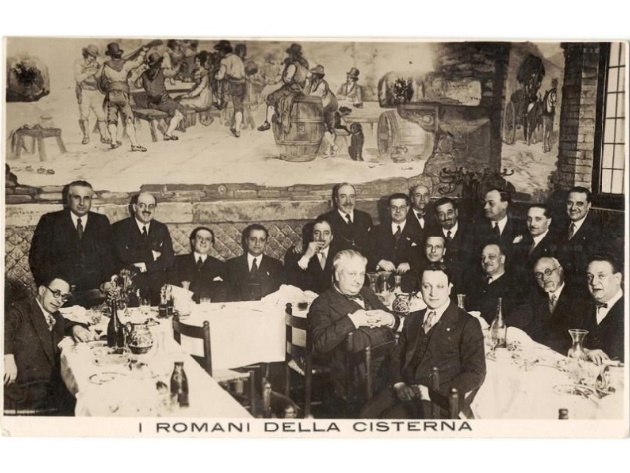
The exhibition displays life and culture in Rome between the end of the 1920s and 1940, witnessed from the specific perspective of the scholars, academics, and city connoisseurs, known as the Romanisti, who, in various circles and literary salons of the Capital, favoured the birth and diffusion of passionate studies and the lively promotion of Rome related culture.
Roman and foreign intellectuals promoted the literary, artistic, antiquary, and entertainment phenomena by meeting in a circle of friends initially known as Romani della Cisterna. They acquired a stable physiognomy at the end of the 30s when they officially established an association known as Gruppo dei Romanisti.
Their main objective was the advancement of studies on Rome and their dissemination. The Roman spirit had to be kept alive; the historical-artistic heritage, the events, the illustrious men, the traditions, and the dialect highlighted.
The exhibition presents five sections and about 100 works, including painting, sculpture, graphics, photography, and documents, mainly from the Museum of Roma, the Gallery of Modern Art, the Museum of Roma in Trastevere, the Trilussa funds of the Sovrintendenza Capitolina and from the Archive of the Gruppo dei Romanisti.
Romani della Cisterna introduces the Osteria della Cisterna in Trastevere, where, in 1929, Ettore Petrolini, Trilussa, Augusto Jandolo, Giuseppe Ceccarelli, Vitaliano Rotellini, Ettore Veo, Franco Liberati, and Ignazio Mascalchi decided to found the cenacle of authentic Romans. Always noisy and animated, their meals witnessed discussions on artistic, literary, or archaeological questions and transformed the tavern into an academy.
La passione antiquaria illustrates how, in the 1930s, Rome was the protagonist of an exceptional urban expansion with radical demolition interventions. Thus, many illustrious antiquarians, archaeologists, and art historians such as Ferdinando Castagnoli, Massimo Pallottino, Carlo Pietrangeli, Pietro Romanelli, Richard Krautheimer, Antonio Muñoz, Diego Angeli, supporters of the Gruppo dei Romanisti, arose the need to preserve and restore the vast archaeological and artistic heritage of the city.
Con Trilussa is the title of the third section dedicated to the co-founder of the first nucleus of the Romanisti della Cisterna and a great friend of Ettore Petrolini, Carlo Alberto Camillo Salustri, who, under the anagrammatic pseudonym of Trilussa, was a true protagonist of Roman culture in the 1930s. As a poet, a writer, and a journalist, he has produced a notable patrimony composed, among other things, of the approximately 11,000 documents, works of art, photographs, books, and letters conserved at the Museum of Roma in Trastevere, which allow us to reconstruct the climate and fashion of the time. The relationship he established with personalities such as Luigi Pirandello, Gabriele D'Annunzio, Massimo Bontempelli, Filippo Tommaso Marinetti, and Giacomo Balla tells the story of the brilliant Roman cultural life far from official propaganda.
In Atelier is the fourth section which, set up in the Sala del Pianoforte, tells how in the 1930s, many Roman artists and residents of the Capital devoted themselves to urban landscape painting, representing a part of the medieval city destroyed to make way for fascist Rome. Orazio Amato, Carlo Alberto Petrucci, Orfeo Tamburi, and Diego Angeli, as a painter, were just some of the artists of the Romanisti association. With Duilio Cambellotti and Antonio Barrera, close collaborators of the initiatives organized by the founders of the Romani of the Cisterna, they witnessed the cultural transformation of Rome in the first decades of the 20th century.
Il Gruppo dei Romanisti is the last section. It traces the official birth of the association. In the Via Margutta studio of the antiquarian and poet Augusto Jandolo, the meetings began to take place regularly, on the first Wednesday of each month. In the exhibition, you can admire the annual publication of the Strenna dei Romanisti, the first number of which, of about 100 pages, was born in 1940. Still today, the anthology, with articles, essays, stories, poems, memoirs, and illustrations on Roman subjects, is traditionally delivered by Romanists to the mayor on April 21, the Christmas of Rome, as a tribute and testimony of studies and passion for the city.
From January to May 2023, the cycle of meetings, with conferences, readings, and concerts, Il Gruppo dei Romanisti si racconta, conceived and coordinated by Donato Tamblé, President of the Gruppo dei Romanisti: an opportunity to deepen the documental and narrative horizon of the world of Romanisti up to the present day.
Informations
from 15 December 2022 to 4 June 2023
Tuesday to Sunday from 10.00 to 20.00
24 and 31 December 10.00 - 14.00
Last entrance one hour before closing
Closed on: Monday and 25 December
ALWAYS CONSULT THE ADVISORY PAGE before planning your visit to the museum.
 Condividi
Condividi











































